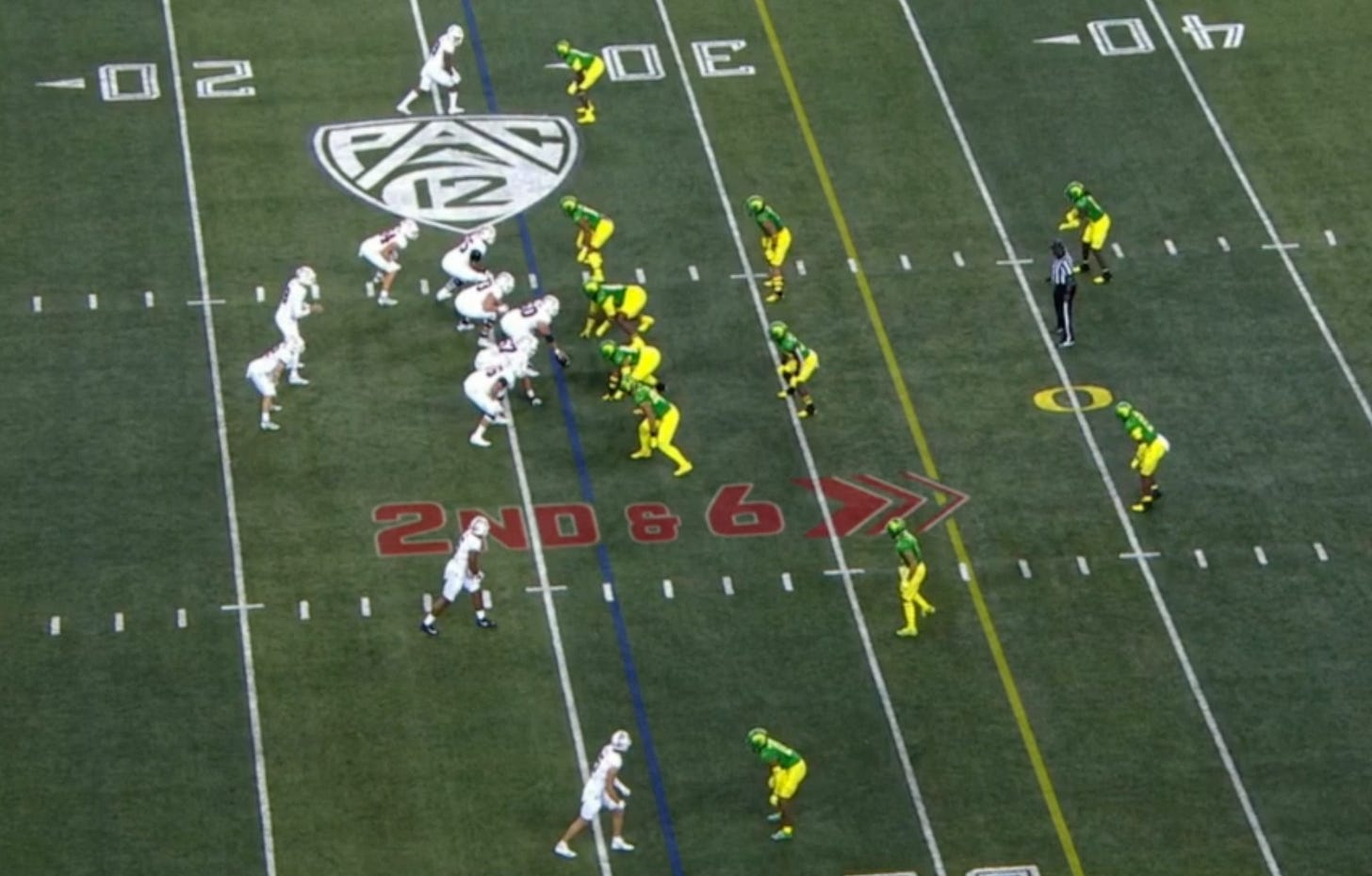Attacking early-downs with an A-gap 5-man pressure
MQ details RAPTORS, a best-practice path that stems from the MEX/Allen Sim.
Off-ball “sims” and five-man pressures attacking the A-gaps have become a popular way to attack spread offenses. Regardless of whether zone or gap scheme is dominant, the popular path is considered a utility pressure. I define utility pressures as paths that can be used on any down and in most situations outside of 3rd & Long.
Off-ball sims “float” the Center and attack the interior of the offensive line. “Floating the Center” refers to the movement of the defense post-snap. The interior defensive line will stunt the B-gaps (or “pin” if in a 3 technique), leaving the A-gaps exposed and no one for the Center to block. Essentially, letting him float in space as the ILB blitzes into one of the A-gaps (below).
Before we go any further, let’s define an off-ball simulated pressure. I separate simulated pressures into two categories, off-ball and presentation. In an off-ball sim, the ILBs are at regular depth and alignment. Post-snap, one of them (or both) will attack the Center, ripping into one of the A-gaps. The pressure looks like an internal blitz, only for one of the DEs to drop out into coverage, creating a four-man rush.
Presentation sims are what you generally see on 3rd Down. The defense presents the offense with five or more defenders on the line of scrimmage (LOS), only to rush four. Defenders outside the box can be added in, but no more than four will rush the QB. In many cases, these pressures are designed to attack the pass protection of the offense.
Simulated pressures are different than Creepers within my definition. Creepers, or replacement pressures, attack the edges of the box (A- or B-gap) and drop a DE opposite the pressure. The technical term “replacement pressure” illustrates the see-saw action of the defense post-snap. Pressure from one side of the box from a second- or third-level defender and a first-level defender dropping into coverage opposite. One of the more popular versions of a Creeper is the Brady (boundary) or Whip (weak) path shown below.
Creepers and off-ball sims are designed as run-stopping pressures that can provide a pass rush if the offense decides to pass. Analytics has changed how offenses play on early or “normal” downs (1st-2nd & 7). Passing on early downs allows the offense to stay ahead of the chains because it is more efficient than running the ball.
Play-action, especially from under the center (UTC), has proven to be a successful way of attacking defenses stressed by uncertainty. To counter the doubt, defenses have turned to off-ball sims and Creepers to attack the run-action while also establishing a pass rush.
Don’t confuse Creepers and off-ball Sims for pass rush. The design and usage of these defensive tools are to mitigate the run while maximizing the coverage ability of the defense. One trend across the higher levels of football is to utilize off-ball ‘backers in the rush more often than bringing secondary players.
Another trend is using five-man pressures (“Adds”) instead of opting for replacement pressures or off-ball Sims. The reason is best described by the Creeper/Sim guru himself, Baylor’s Dave Aranda, in an interview he did with 247Sports in June,
“…you’re getting your d-linemen one-on-one blocks when you’re sending five. You’re trying to get a mismatch there and give them an opportunity to win.”
Aranda is referencing a trend he noticed last season when studying the defending National Champion Georgia Bulldogs, who, in his words, are “a big creeper outfit.” Five-man pressures can be paired with several different coverages. Regardless if a MOFO or MOFC dominant system, adding an extra defender to the rush can create matchup issues and attack the run scheme. Adding a rusher also increases the likelihood that the defense will cause pressure against a play-action scheme.
Fire Zone (3U/3D), Half-Field Zones (Saban Big12s), Trap 2, and Cover 1 are generally the coverages teams pair their five-man pressures with. Fire Zones and Cover 1 are probably the most used pairings. Half-Field Zones require more communication, but if a defense is Quarters dominant, the defense has a man side and a zone side with an automatic “take-back” rule for the #3 defender. Trap 2 is great versus teams that like to run 2x2 formations because, in reality, you are only losing your low-middle-hole players.
When attacking with the ILBs, a defense can run a multitude of coverage types because they are not losing an overhang. The five-man pressure discussed in this article is RAPTORS, which is the “add” version of what I refer to as ALLEN (above), or Aranda’s MEX path. Internal pressure can have a devastating effect on an offense’s blocking and utilizes a best-practice cross-dog action. In addition, the layering of the fit increases the numbers at the point of attack. Let’s break it down with some film.
Keep reading with a 7-day free trial
Subscribe to MatchQuarters by Cody Alexander to keep reading this post and get 7 days of free access to the full post archives.







